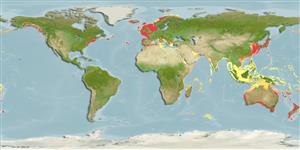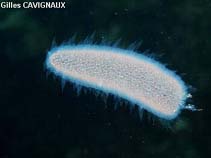Pyrosoma atlanticum Péron, 1804
| Native range | All suitable habitat | Point map | Year 2050 |

|
| This map was computer-generated and has not yet been reviewed. |
| Pyrosoma atlanticum AquaMaps Data sources: GBIF OBIS |
Classification / Names Common names | Synonyms | CoL | ITIS | WoRMS
Thaliacea | Pyrosomatida | Pyrosomatidae
Environment: milieu / climate zone / depth range / distribution range Ecology
Pelagic; depth range 0 - 250 m (Ref. 1134). Subtropical; 7°C - 30°C (Ref. 1134)
Distribution Countries | FAO areas | Ecosystems | Occurrences | Introductions
Atlantic, the Mediterranean and Indo-Pacific. Tropical to temperate.
Length at first maturity / Size / Weight / Age
Maturity: Lm ? range ? - ? cm Max length : 60.0 cm COLD male/unsexed; (Ref. 1610)
Life cycle and mating behavior Maturity | Reproduction | Spawning | Eggs | Fecundity | Larvae
Main reference
References | Coordinator | Collaborators
Kott, P. 2005 Catalogue of Tunicata in Australian Waters. Queensland Museum, Brisbane, Australia Department of the Environment and Heritage. (Ref. 1134)
IUCN Red List Status
(Ref. 130435: Version 2025-1)
CITES status (Ref. 108899)
CMS (Ref. 116361)
Threat to humans
Human uses
| FishSource |
Tools
More information
Max. ages / sizes
Length-weight rel.
Length-length rel.
Length-frequencies
Mass conversion
Abundance
Internet sources
BHL | BOLD Systems | CISTI | DiscoverLife | FAO(Publication : search) | Fishipedia | GenBank (genome, nucleotide) | GloBI | Gomexsi | Google Books | Google Scholar | Google | PubMed | Tree of Life | Wikipedia (Go, Search) | Zoological Record



